Caulerpa taxifolia
Introduction
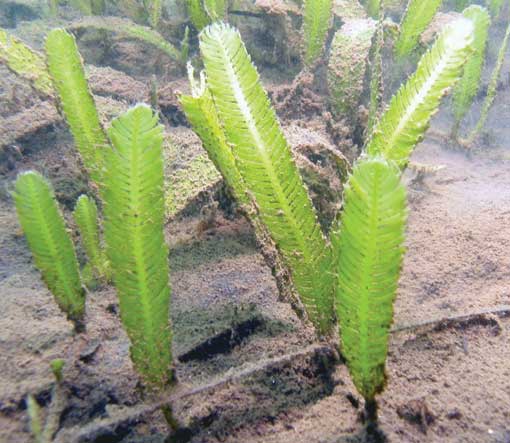
Caulerpa taxifolia (Caulerpa) is a fast growing marine alga native to tropical Australia and the South Pacific that has colonised various areas outside its natural range, including several NSW waterways. Caulerpa was first found in NSW in April 2000 and is known to have spread to a total of 14 NSW estuaries or lakes, from Lake Macquarie in the north to Wallagoot Lake in the south.
In the past, Caulerpa has been widely used as a decorative plant in the NSW marine aquarium trade. This alga can invade cool temperate waters and Caulerpa has become established in several countries and areas outside its natural range.
Caulerpa is a listed species in all NSW waters under the relevant legislation. It is illegal to possess or sell the alga and heavy fines apply. Legislative powers also enable authorised officers to seize and destroy Caulerpa, or require its destruction.
The invasive potential of Caulerpa has raised concerns as it can grow rapidly, alter marine habitats and affect biodiversity, although it is no longer considered as severe in NSW as was once thought.
Aquatic pests, including Caulerpa are usually extremely difficult to eradicate once they have become established in the wild. It is therefore important to prevent introduced species such as Caulerpa from entering new waterways.
Identification
Key features
- Frond height 3-25cm
- Flattened feather-like fronds, bright green colour
- Known to turn pale and white during winter in colder waters
- Leaflets on fronds attach directly opposite each other, curve upwards
- Leaflets constricted at base
Similar native species
These native species may be confused with Caulerpa taxifolia.
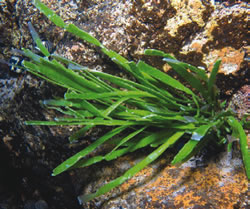
Caulerpa filiformis
Key features
- Flattened strap-like fronds (not feather-like)
Habitat
- Exposed and sheltered rocky reef and sandy areas, to 6m depth
- Common between Port Stephens and Jervis Bay

Caulerpa scalpelliformis
Key features
- Fern-like fronds with leaflets either side of fronds not directly opposite each other
Habitat
- Exposed rocky reef to 36m depth
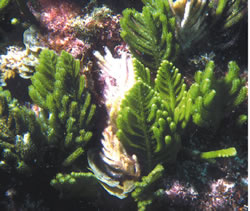
Caulerpa flexilis
Key features
- Fern-like branchlets with secondary leaflets
Habitat
- Exposed rocky reef to 40m depth
- More common in deeper water
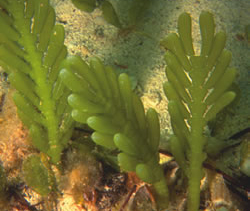
Caulerpa cactoides
Key features
- Short rounded club-like leaflets
Habitat
- Sheltered and less exposed sand, mud and rock surfaces up to 38m depth
Natural distribution & biology
Caulerpa is native to tropical regions throughout the world, including tropical and subtropical parts of Australia.
It was first identified outside its natural range near Monaco in the Mediterranean Sea in 1984. It was dubbed the aquarium strain as it was believed to have been accidentally released from fish tanks. It has since colonised thousands of hectares in the Mediterranean from France to Croatia (although some populations have experienced dieback in recent years) and has also colonised two locations in California.
Caulerpa is a green marine alga with regularly-spaced feather-like fronds growing along a running stolon that is attached to the substrate. The fronds vary in length, and have been reported to reach a maximum of 30cm in NSW waters.
It can tolerate low temperatures and NSW researchers have confirmed that it can survive out of water, in moist conditions, for up to 3 days. It can colonise most kinds of environments including rock, sand, mud and seagrass beds. In NSW, it has been found in depths ranging from less than 1m to 12m.
Caulerpa reproduces sexually and asexually and dispersal occurs through fragmentation. It has been demonstrated in laboratory experiments that a fragment as small as 1 cm can settle and start growing. Growth rates are greatest in the warmer months and lowest during winter.
Where is it in NSW?

Caulerpa was first identified on the east coast of NSW during April 2000 in Port Hacking, 30km south of Sydney, and has been detected in 14 estuaries and one oceanic population (near Cronulla) in NSW, as indicated in the image below. From 2000 until 2014 the department has made observations of changes in the distribution of the species over time in the known locations. In recent years, between 2011 and 2014, the density of Caulerpa populations was observed to be significantly reduced in most southern estuaries as a result of natural fluctuations in salinity and temperature.
The abundance of Caulerpa in all south coast estuaries (St Georges Basin, Lake Conjola, Narrawallee Inlet, Burrill Lake, Durras Lake and Batemans Bay was observed during 2011/12 to have declined to a point that none could be found (based on department transect surveys). The recent decline in Caulerpa (and native seagrass) in south coast estuaries may be a result of fluctuations in salinity (due to a drought followed by major rainfall events in 2011 and 2012). It is quite possible that small Caulerpa beds may remain in many south coast estuaries. In contrast, Caulerpa abundance in most Sydney estuaries has remained relatively stable over recent years.
Previous active monitoring projects involving Caulerpa by DPIRD have now concluded and monitoring of Caulerpa by DPIRD will no longer continue. Records of our surveys are included in cumulative distribution maps (showing all known locations from historical data) of Caulerpa below. These archival maps will not be updated.
Important note: The following maps are indicative only and may contain errors and omissions. Maps are based on surveys of selected areas within the waterways not on exhaustive searches. Caulerpa may occur in additional areas not shown on the maps. Furthermore, the distribution of Caulerpa can change markedly over time, either expanding or contracting (for example, it can die back during winter and grow rapidly in summer). The maps show where Caulerpa has been found at some point in the period specified in each particular location.
NSW DPIRD and its employees disclaim liability for any act done on the basis of information from these maps and any consequences of such acts or omissions.
For more detail information, scroll down to Location resources.
Report Sightings
Please report any new sightings or changes in the distribution of Caulerpa taxifolia.
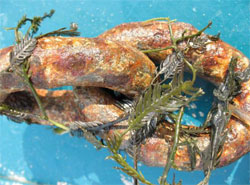
How did it get here?
The origin of the NSW populations is unclear, but the alga is likely to have been introduced from an aquarium release, for example by cleaning tanks and disposing of waste or unwanted alga into a waterway.
After arriving in NSW, Caulerpa seems to have been spread from one estuary to another by fishing and boating activities. Spread within affected estuaries may also occur through natural means (wind, waves, tides and currents).
Fragments of Caulerpa can be spread by anchor chains - see image at right.
What are its impacts?
Since Caulerpa was first discovered in NSW in 2000, studies have been undertaken to determine the effects of the marine alga on aquatic ecosystems. The impacts of Caulerpa infestations on local seagrass populations have been well researched throughout the world (Ceccherelli and Cinelli 1997; Ceccherelli and Sechi 2002; Holmer et al. 2009).
There are two key characteristics of Caulerpa that may have helped it to establish and spread in areas outside its natural range. Firstly, Caulerpa can grow rapidly, leading to concerns it could out-compete native seagrass. Secondly, small fragments of Caulerpa can grow into new plants and create large colonies.
Since the initial discovery of Caulerpa in NSW research activities and observations indicate that the impacts of Caulerpa (especially on seagrasses) are not as severe as first considered. Research in NSW indicates that Caulerpa does not kill native seagrasses as once thought (Glasby 2013). Rather, it tends to grow primarily on the edges of seagrass beds and less commonly is found interspersed with seagrass.
Caulerpa opportunistically occupies suitable uninhabited space. Caulerpa has been found to create habitat that is similar to native seagrasses in some regards (e.g. for some fishes, but not seahorses; York et al. 2006), but it can differ from native seagrass habitats in relation to invertebrates living in the sediments (Gallucci et al. 2012; Gribben et al. 2013). The latter differences appear to be driven by the differences in sediment chemistry with Caulerpa beds compared to non-vegetated sediments, but more research is needed to investigate what extent these differences are driven by the density of vegetation as compared to the type of vegetation (e.g. Caulerpa versus seagrasses; Eyre et al. 2011).
Research by Gribben and Wright (2006) focusing on the impacts of Caulerpa on invertebrates living in and on sediments has found that the cockle Anadara trapezia recruits in greater numbers to Caulerpa than to seagrass or unvegetated areas, but that the survival and reproductive output of females cockles is less in Caulerpa. These observed impacts on invertebrates appear to be as a result of low levels of oxygen in water and in the sediments under Caulerpa. Taylor et al. (2010) demonstrated that when Caulerpa gets washed onto the shore (“wrack”) and decomposes, the detritus it creates can adversely affect invertebrates living in intertidal sediments.
What is DPIRD doing?
After 15 years of published research and scientific observations in NSW, the behaviour of Caulerpa in the NSW environment is now better understood and we are changing the way we manage it.
We believe our efforts will be more effective if we focus on preventing the spread of Caulerpa to unaffected estuaries, rather than on activities that have little effect on established populations.
Large outbreaks of Caulerpa are almost impossible to eradicate, require extensive resources and cannot guarantee that Caulerpa will not reoccur so control activities will generally no longer be supported by DPIRD, unless in exceptional circumstances in a newly affected estuary.
We encourage people to “Make clean part of your routine” by checking for Caulerpa when fishing and boating and safely disposing of it. Fishers and boaters will be required to clean their gear and equipment before leaving affected estuaries to minimise the risk of further spread.
DPIRD will continue to issue advisory information that educates people about the importance of implementing good hygiene measures when leaving affected waterways to minimise the potential for spread of this marine alga to new waterways.
It is illegal to possess or sell Caulerpa and heavy penalties will continue to apply.
For additional information on changes to management, see Management of Caulerpa in NSW – Frequently Asked Questions
DPIRD will continue to support research by universities to investigate the potential impacts of Caulerpa on fishes, invertebrates and nutrients in sediments. We will also continue to investigate reports of Caulerpa infestations only in waterways where it has not previously been known to occur.
How you can help
The DPIRD Aquatic Biosecurity team encourages waterway users to be vigilant to help minimise the spread of Caulerpa to unaffected estuaries.
We encourage you to inspect all fishing and boating gear and remove and dispose of fragments by placing them in a plastic bag and into general waste. After removing all visible fragments anchors, chains and other gear should be washed using freshwater before moving to another estuary.
Ensure that you do not have Caulerpa in your aquarium – it is illegal in NSW! If you do, dispose of it immediately by placing it in a plastic bag in your freezer for at least 24 hours, and then placing it in the garbage. NEVER release Caulerpa into a stormwater drain, river, creek, bay, lagoon, or the ocean.
If you have visited an infested estuary, inspect your anchor and chain, all fishing and diving gear, wetsuits, boat trailer, outboard motor and vessel. If you find any fragments of Caulerpa dispose of them in a bin to prevent contamination of other waterways. For good hygiene tips, see Make ‘clean’ part of your routine (PDF, 385.23 KB).
Avoid boating, fishing or anchoring in areas near Caulerpa outbreaks.
For more information on how to clean your boat to prevent the spread of Caulerpa and other marine pests you can download the booklet for recreational boaters (PDF, 1142.35 KB).
Report sightings
If you think you have found Caulerpa in a new area, take a photograph or collect a sample and immediately report it!.
Further reading
- Caulerpa taxifolia in NSW (Primefact 1471) (PDF, 237.41 KB)
- Management of Caulerpa in NSW – Frequently Asked Questions
- Make ‘clean’ part of your routine (PDF, 385.23 KB)
- Booklet for recreational boaters (PDF, 1142.35 KB)
References
- Ceccherelli, G. and Cinelli, F. 1997. Short-term effects of nutrient enrichment of the sediment and interactions betweenm the seagrass Cymodocea nodosa and the introduced green alga Caulerpa taxifolia in a Mediterranean bay. J Exp Mar Biol Ecol 217:165-177.
- Ceccherelli, G. and Sechi, N. 2002. Nutrient availability in the sediment and the reciprocal effects between the native seagrass Cymodocea nodosa and the introduced rhizophytic alga Caulerpa taxifolia. Hydrobiologia 474:57-66.
- Eyre, B.D., Maher, D., Oakes, J.M., Erler, D.V., Glasby, T.M. 2011. Differences in benthic metabolism, nutrient fluxes, and denitrification in Caulerpa taxifolia communities compared to uninvaded bare sediment and seagrass (Zostera capricorni) habitats. Limnology and Oceanography 56: 1737–1750.
- Gallucci, F., Hutchings, P., Gribben, P.E., Fonseca, G., 2012. Habitat alteration and community-level effects of an invasive ecosystem engineer: a case study along the coast of NSW, Australia. Marine Ecology Progress Series 449, 95-108.
- Glasby, T.M. 2013. Caulerpa taxifolia in seagrass meadows: killer or opportunistic weed? Biological Invasions 15: 1017-1035.
- Gribben, P.E. and Wright, J.T. 2006. Sublethal effects on reproduction in native fauna: are females more vulnerable to biological invasion? Ocologia 149:352-361.
- Gribben, P.E., Wright, J.T., Byers, J.E., Glasby, T.M., 2013. Positive versus negative effects of an invasive ecosystem engineer on different components of a marine ecosystem. Oikos 122, 816–824.
- Holmer, M., Maraba, N., Lamote, M. and Duarte, C.M. 2009. Deterioration of sediment quality in seagrass meadows (Posidonia oceanica) invaded by macroalgae (Caulerpa sp.). Estuaries Coasts 32:456-466.
- Taylor, S.l., Bishop, M.J., Kelaher, B.P. and Glasby, T.M. 2010. Impacts of detritus from the invasive alga Caulerpa taxifoliaon a soft sediment community. Marine Ecology Progress Series 420:73-81.
- York, P.H., Booth, D.J., Glasby, T.M. and Pease, B.C. 2006. Fish assemblages in habitats dominated by Caulerpa taxifolia and native seagrasses in south-eastern Australia. Marine Ecology Progress Series 312:223-234.
Location resources
This invasive seaweed has been identified in the following locations:
- Pittwater (Map based on survey data since 2001) (PDF, 1.9 MB)
- Lake Conjola (Map based on survey data since 2000) (PDF, 743.8 KB)
- Burrill Lake (Map based on survey data since 2001) (PDF, 715.8 KB)
- Batemans Bay (Map based on survey data since 2007) (PDF, 608.0 KB)
- Botany Bay (Map based on survey data since 2001) (PDF, 2.6 MB)
- Brisbane Water (Map based on survey data since 2006) (PDF, 2.3 MB)
- Durras Lake (Map based on survey data since 2007) (PDF, 430.5 KB)
- Lake Macquarie (Map based on survey data since 2001; however, considered Caulerpa free since 2009 until reconfirmed in 2015) (PDF, 3.2 MB)
- Hawkesbury River - Patonga (Map based on survey data since 2007) (PDF, 349.3 KB)
- Port Hacking (Map based on survey data since 2000) (PDF, 1.6 MB)
- Port Jackson (Map based on survey data since 2002) (PDF, 1.7 MB)
- Wallagoot Lake (Map based on survey data since 2007) (PDF, 343.7 KB)